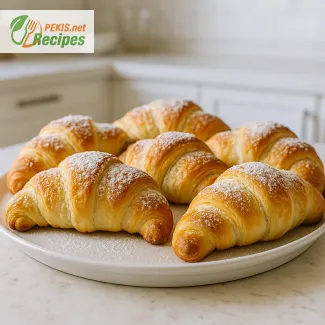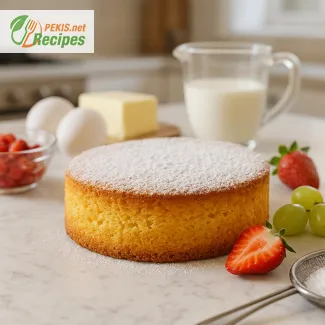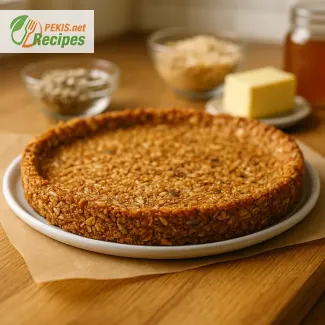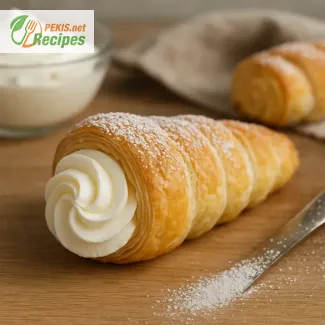Soft homemade donuts without oily taste bring a warm, comforting sweetness that feels like something lifted straight from a small European bakery. The enriched dough creates a pillowy, cloud-soft texture that stays light and clean, without the heavy aftertaste often found in deep-fried treats. With vanilla, lemon zest, and gently aerated strands inside each donut, the flavor feels both nostalgic and elevated. This recipe’s roots lie in traditional festive doughs, but its modern balance of ingredients ensures a consistently soft crumb and a golden exterior that never turns greasy.
Drawing on years of testing dough hydration and quiet early-morning frying sessions, the smallest adjustments in temperature and resting time often make the biggest difference in achieving soft, clean-tasting donuts. A simple shift—like letting the dough relax a little longer before cutting—helps the crumb open into those delicate strands that feel almost weightless when you bite into them.
PEKIS – professional chef and recipe developer with more than 25 years of experience in cooking and baking, specialized in European and international cuisine.
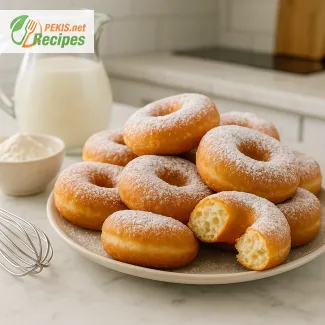
Cloud-soft donuts with clean flavor and perfect texture
A sensory, warm and deeply satisfying introduction to truly soft donuts
Warm sweetness rises the moment the first piece of dough touches your hands, carrying that familiar bakery scent that promises something soft, fluffy, and irresistibly pillowy. The texture feels almost weightless, stretching gently before bouncing back with that subtle elasticity only a well-hydrated dough can offer. As steam escapes during frying, the inside opens into delicate strands—fine, airy, almost feathery—while the exterior remains gently golden without turning greasy. The clean flavor lets the vanilla and citrus notes shine through, avoiding the heavy, oily aftertaste that often overshadows classic donuts. Each bite melts softly, leaving a light sweetness and a tender crumb that makes reaching for the next piece almost unavoidable.
Behind this kind of softness is a careful balance of ingredients that support moisture, structure, and lightness at the same time. A richer fat source brings tenderness, while milk proteins create a velvety mouthfeel. A controlled frying temperature ensures a crisp but thin exterior that does not absorb excess oil, keeping the overall taste pure. Gentle kneading and resting help gluten relax into long, silky fibers, contributing to that cloud-like interior. When everything aligns, the result feels more like a bakery-style treat than a homemade attempt—consistent, fragrant, and perfectly balanced in sweetness and texture.
The roots of these donuts reach back to old European traditions, where enriched doughs were used for festive celebrations. Many regions developed their own versions—from soft Austrian Krapfen to Italian bomboloni—and all share a focus on achieving volume, delicate crumbs, and a subtle buttery aroma. Over time, cooks refined the process to avoid heavy frying, relying on well-fermented doughs and steady temperatures to maintain lightness. Today, the same principles shape modern methods that highlight clean flavor, soft texture, and consistent results without excessive oil.
Ingredient interactions that shape softness and flavor
A smooth, tender crumb comes from the balance of moisture-absorbing flour, structure-building proteins, and ingredients that enrich the dough. Milk brings natural sugars and proteins that deepen browning and aroma. Eggs give body and a naturally silky consistency. A touch of fat creates softness and prevents the crumb from drying. Sweeteners help develop color and enhance the subtle taste. Zest or vanilla introduces aroma without overwhelming the dough’s delicate character.
Storage and make-ahead tips
These donuts stay at their best when enjoyed fresh, but careful handling keeps them enjoyable longer. A breathable container prevents condensation from softening the crust. Rewarming them briefly brings back the tender texture without drying the interior. Preparing the dough ahead and letting it rest in the refrigerator overnight helps flavor deepen while keeping the process flexible for busy days.
Donut textures, serving styles and related techniques
Different textures—from ultra-soft strands to slightly denser festival-style doughs—depend on hydration and resting time. Longer fermentation enhances aroma, while shorter resting delivers a simpler, lighter sweetness. Variations in shaping allow filled, ring-style, or mini versions to shine, each offering different ways to serve them warm, dusted, filled, or glazed.
If you enjoy soft doughs that stay light without oiliness, there is also a recipe for no-yeast donuts available: Quick and Easy No-Yeast Doughnut Recipe.
Why this recipe wins for consistency
- Soft interior with fine, elastic strands
- Clean flavor without oily notes
- Golden exterior that stays thin and delicate
- Reliable texture even for beginners
- Warm aroma from enriched dough and gentle browning
Creative variations you can explore
- Add citrus zest for a brighter aroma
- Fill with vanilla cream or jam for a richer treat
- Shape into mini donuts for faster frying
- Use a lighter glaze for a glossy finish
- Add warm spices for a seasonal version
Sensory and structural properties of enriched donuts
Understanding the interaction between gluten development, moisture retention, and controlled frying leads to donuts that feel airy yet substantial. Proper resting relaxes the dough, while balanced hydration allows the crumb to expand naturally. The frying stage enhances both aroma and mouthfeel, creating the delicate contrast between tender interior and lightly crisp exterior that defines this style of soft homemade donut.
- Warm the milk to a gentle lukewarm temperature, about 38°C (100°F). Combine with yeast and sugar, letting the mixture stand until lightly foamy.
- In a large bowl, whisk the eggs, melted butter, vanilla, and lemon zest until smooth.
- Add the flour and salt, then pour in the yeast mixture. Begin mixing until the dough starts forming soft clusters.
- Knead for 8–10 minutes until the dough becomes smooth, elastic, and slightly shiny. It should feel soft but not sticky.
- Transfer to a lightly oiled bowl, cover, and let rise for 60 minutes or until doubled in size.
- Roll the dough to a thickness of 1.5 cm (0.6 inch) on a lightly floured surface. Cut out donut shapes using a round cutter.
- Place the cut donuts on parchment, cover loosely, and let rest for another 20 minutes to relax the gluten and improve fluffiness.
- Heat oil to 170°C (340°F). Maintain the temperature steadily for even frying and minimal oil absorption.
- Fry donuts in small batches for 1–2 minutes per side until golden. Avoid overcrowding to prevent temperature drops.
- Drain on a cooling rack, then dust with powdered sugar (decoration).
- Serve warm for best texture, or store once completely cool.
FAQ questionHow do you keep homemade donuts soft and fluffy for longer?
Softness comes from a balance of hydration, fat, and gentle handling. A slightly higher liquid content keeps the crumb moist, while butter and eggs enrich the dough and prevent it from drying out. Avoid adding too much flour during kneading; the dough should feel smooth, elastic, and just a little tacky, not stiff. Letting the dough rest properly allows gluten to relax and air pockets to form, which creates that pillowy, cloud-like interior. Once fried, cool donuts on a rack instead of a plate so steam can escape and the texture stays light instead of soggy.
FAQ questionHow do you stop donuts from tasting oily after frying?
An oily taste usually comes from incorrect oil temperature or from using oil that has been overheated and reused too many times. Keep the oil at a stable 170–175°C (340–347°F); if it is too cool, the donuts absorb oil, and if it is too hot, the outside browns before the inside cooks. Fry in small batches so the temperature does not drop suddenly. Choose a neutral, high-smoke-point oil, and strain or replace it regularly. A well-risen dough that goes into properly heated oil will form a thin, sealed crust quickly, which helps block excess oil absorption and keeps the flavor clean.
FAQ questionWhy is my donut dough dense instead of light and airy?
Dense donuts usually mean the dough has not risen enough, has been overworked, or the yeast was not active. Make sure the milk is only lukewarm, not hot, so it does not kill the yeast. Allow enough rising time until the dough has visibly doubled in size, even if that takes a bit longer on a cooler day. When shaping, handle the dough gently and avoid pressing out all the trapped air. Over-kneading with too much added flour can tighten the structure, while under-kneading leaves it weak. The goal is a smooth, stretchy dough that springs back slowly when pressed with a fingertip.
FAQ questionCan this soft donut recipe be adapted for fillings and glazes?
Yes, the same base dough works beautifully for filled donuts, glazed donuts, and mini versions. For filled donuts, cut slightly thicker rounds and skip the central hole so there is enough space for cream, jam, or custard. Make sure they cool almost completely before piping in the filling to preserve structure. For glazed donuts, let them rest on a rack until just warm, then dip in a thin sugar, vanilla, or citrus glaze so it sets into a delicate, shiny coating. Because the dough is soft and enriched, it pairs well with both light glazes and richer fillings without feeling heavy.
FAQ questionWhat is the best way to store soft homemade donuts and reheat them?
These donuts are at their best on the day they are fried, but careful storage keeps them pleasant. Once completely cool, place them in a loosely closed container or paper bag at room temperature; trapping too much moisture in an airtight box can make the surface soggy. For short-term storage, up to a day, this is usually enough. To refresh, warm them briefly in a low oven for a few minutes until the crumb softens again. Avoid microwaving for too long, as it can make the texture rubbery. For slightly longer storage, donuts can be frozen without decoration and then gently reheated and dusted or glazed just before serving.
A warm, tender donut with a clean, delicate flavor feels instantly satisfying, especially when the texture stays light and airy without the heaviness of excess oil. The gentle sweetness, soft crumb, and subtle aroma of vanilla and citrus create a balance that makes each bite feel comforting and effortless. When the dough is treated with patience and steady frying temperature, the result consistently delivers that bakery-style softness at home.
The combination of enriched ingredients and controlled heat helps the donuts maintain their cloud-soft interior while forming a thin, golden exterior. This contrast in textures is what makes them stand out: a tender structure inside and a barely crisp shell that melts as soon as it touches the palate. With a smooth rise and proper resting time, every donut becomes naturally light, avoiding dense or oily results.
Mastering small details—hydration, resting, shaping, and temperature—unlocks a method that feels repeatable and dependable. Each step works together to preserve moisture while preventing heaviness, creating donuts that retain their freshness longer and taste refined rather than greasy. That harmony of technique and simplicity is what gives this recipe its long-lasting appeal.
Whether served warm with powdered sugar or transformed into filled or glazed versions, the donuts adapt beautifully to different preferences. Their soft, clean-tasting profile makes them a versatile base for variations, celebrations, or casual weekend baking. The method supports consistency while leaving room for personal touches, ensuring every batch stays light, flavorful, and irresistibly tender.
Allergens present in the recipe:
- Gluten: from wheat flour
- Eggs: present in the dough
- Milk: from butter and milk
Allergen and gluten-free substitution tips:
- Gluten-free flour blend can replace wheat flour; add a binder such as psyllium for elasticity.
- Plant-based milk may replace dairy milk.
- Vegan butter substitute can be used instead of butter.
- Egg replacer (commercial powder or aquafaba) can replace eggs for those with egg allergies.
- Vitamin B2 (mg): 0.12 – supports energy release
- Vitamin B12 (µg): 0.18 – contributes to normal nerve function
- Calcium (mg): 34 – important for bone balance
- Iron (mg): 1.3 – supports oxygen transport
- Potassium (mg): 95 – helps regulate fluid balance
- Polyphenols (mg): 8 – mild support for cellular protection
- Carotenoids (mg): 0.05 – contributes to natural color and protection
- Flavonoids (mg): 3 – gentle antioxidant activity
